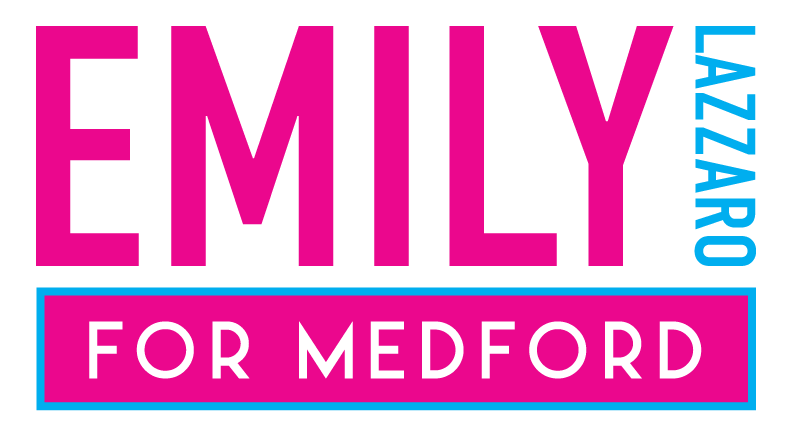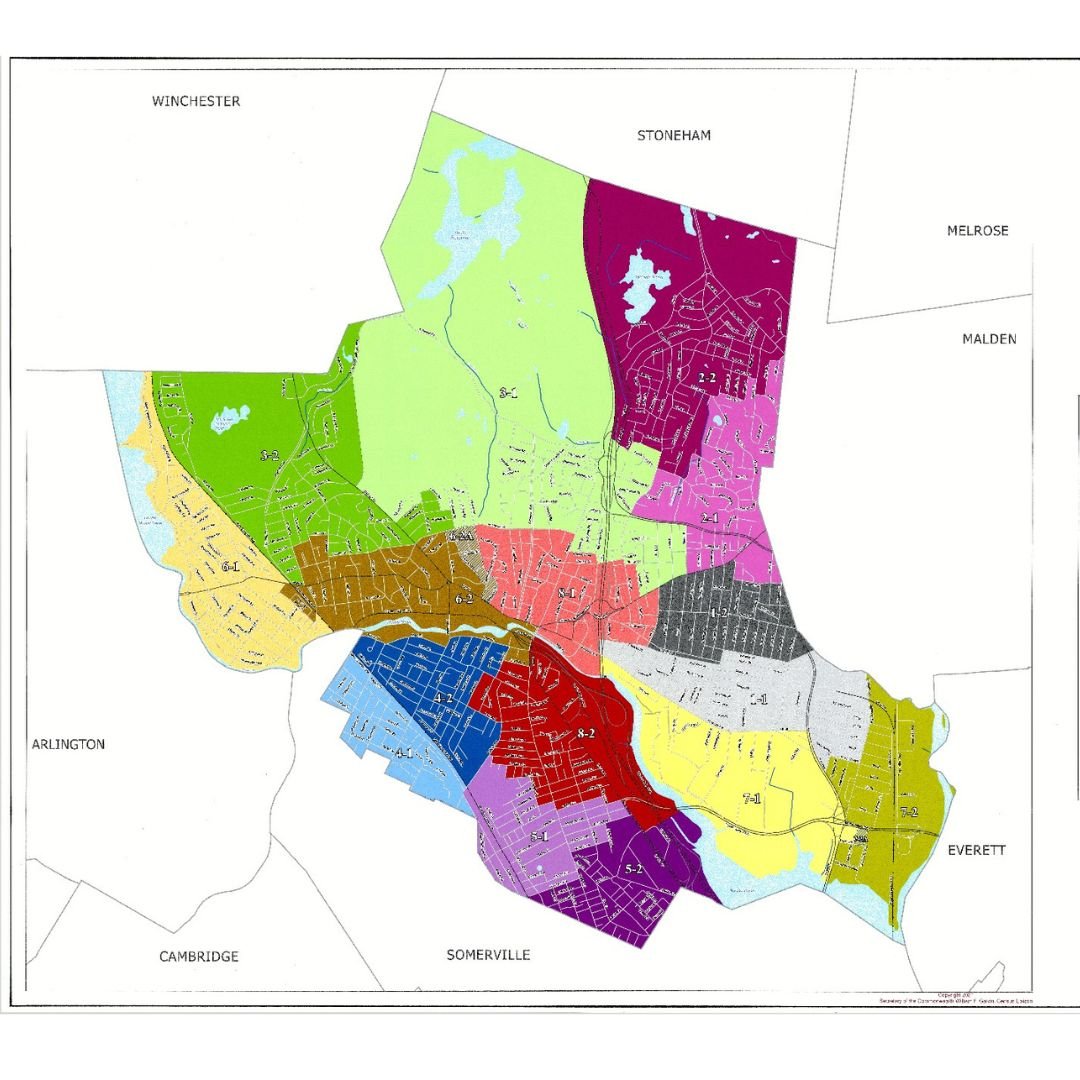On Diversity, the Searing Pain of Editing, and Medford’s City Charter
Map of Medford with Wards and Precincts
Last night, the City Council’s Governance Committee met to discuss a few sections of the draft version of a City Charter that can then go to the State, to eventually be presented to the City’s voters, which, if approved, would be implemented in 2027. Any new charter will be a huge improvement and I am delighted at the privilege to do this work. A committee was appointed by Mayor Lungo-Koehn to study the charter years ago. They convened, researched extensively, held many public meetings, conducted surveys of residents, and put together an excellent draft charter. Now the City Council Governance Committee is reviewing the draft and making amendments, which will be voted on by the full City Council, which will then go to the Medford State Delegation (our Senator and House Representatives) who will hopefully pass it through the State House, and then it goes on the ballot for a vote this November.
We talked last night about one particularly contentious matter: the composition of the City Council. Many other cities in Massachusetts and across the country have ward- or precinct- or district-based Councils. Ours is currently only at-large councilors, meaning all the members of the Medford City Council represent the whole City of Medford, all roughly 60,000 residents. There are good and bad things about this. It is nice that every resident of Medford has 7 people they can contact with an issue and every Councilor ostensibly cares equally about every neighborhood in the City. The downside is that it’s expensive and time-consuming to run for office, especially for a new candidate. This precludes many people from running for office who might otherwise want to. Removing this barrier by having ward-based City Councilors seems like a no-brainer. This was one of the tenets of my platform when I ran for office a year and a half ago.
One of the recommendations of the Charter Study Committee was to change the composition of the City Council from 7 at-large Councilors to 8 ward-based Councilors and 3 at-large Councilors. The idea is that this will open up opportunities to underserved wards (some wards haven’t had a City Councilor from that ward since at least 2005), will make it easier for people from historically marginalized backgrounds to run for office, or people with families, demanding jobs, or lower income, to run for office. I believe this is true! I am all for this.
City Council President Zac Bears offered an amendment to this section suggesting that instead of 8 ward-based Councilors, we try a compromise of combining the wards into districts of two wards each, based on the CSC’s recommendations for the School Committee composition. We would try 4 district Councilors and 3 at-large Councilors. At the Governance meeting, Vice President Kit Collins offered a further amendment to 5 at-large Councilors, to grow the size of the City Council to 9 total members. This option could solve for the concern about low turnout in some wards, the concern in many neighboring communities about ward Councilors frequently running unopposed term after term, uncompetitive elections, misalignment with the CSC’s recommendations for School Committee, potential for ward Councilors being overly concerned with parochial issues and NIMBYism, it could solve a lot of issues.
I had planned to vote in favor of that amendment, but changed my mind right before the meeting. I received a lot of emails in favor of a hybrid at-large/ward-based City Council composition. I read all the threads online I could find and almost everything I saw expressed that preference. The CSC’s survey showed that preference. I often struggle with the concept of representative democracy versus leading the people in the direction I personally think is best. I also struggle with knowing if the people talking to me are the actual majority or just the loudest voices in the room. The survey conducted by the CSC only offered fully at-large, fully ward-based, and a hybrid version as options, so there were some limitations, but these were the data we had to work with.
I voted against President Bears’ amendment, meaning I voted to keep the CSC’s suggestion of a Council of 8 ward-based Councilors and 3 at-large Councilors. I decided to do that because of my campaign promise, the emails I received, and conversations I had with residents and members of the CSC. That being said, I believe that if we have 11 councilors, City Council meetings will be too long. They are already too long and it is an additional barrier for new candidates running for office. We currently have no limit on how long a City Councilor can speak and we are outliers in the amount of public participation that happens in our meetings compared with the rest of the state. If there are 11 Councilors, I will lobby heavily for additional limits to meeting lengths, both in the time Councilors are permitted to speak and the amount of public participation that is offered in our meetings.
President Bears’ suggestion that we combine wards, in alignment with the recommendation by the CSC for School Committee, was met with insinuations of corruption, immediately. That was wild! The suggestion that my colleagues would spend their time and energy crafting an amendment to the City Charter for nefarious ends, so they can keep an elected position that equates to long hours late at night, endless work, research and emotional labor, and frequent online attacks and doxxing boggles my mind. This is not an easy role, nor a lucrative one. No one runs for office for the glamor or the money. I was at work at 1am on my 40th birthday, being told I was disgusting for voting in favor of rezoning.
It was as though, by doing our jobs and making amendments to the draft of the charter, we were showing disrespect to the Charter Study Committee. It is explicitly our responsibility to review the CSC’s draft and make productive, constructive amendments. That is our charge, our mandate, our job. We hadn’t even deliberated on it and immediately, the assumption was that we were doing a power grab.
(Permit me an empathetic sidebar: I have an MFA in creative writing and have written many plays, personal essays, and a novel. Every time I complete a first draft, I am convinced she is a perfect piece of art, more wonderful than anything anyone has ever written. I give this beautiful piece of writing to someone to read, and they say it’s good and then give me edits, and it feels like they are murdering my babies. I relate to the pain of having your work edited. I apologize for inflicting that upon the CSC.)
There is a very pure and good desire, that I believe the members of the CSC hold, and I held during my campaign, that ward-based representation will make our majority white City Council more diverse.
Having ward representation will definitely make it easier for someone to run for City Council, which will be a good thing. It will also be easier to run for a district seat (i.e. two wards combined into one district) than it was to run at-large. I was on the losing side of the vote and President Bears’ amendment passed in Committee. I am fine with that. District representation is still a step in the right direction and brings us in alignment with the recommendations for School Committee. But one thing to keep in mind is that making it easier to run for office will not necessarily mean our district candidates will be people of color or women or queer people. There is more work to do.
Representation matters. And it takes more than offering this charter change to achieve true representation. This will be one step, and in the meantime, we can make the whole of our government more representative, more welcoming, and more open by passing ordinances that do that now.
We actually have been doing that, by changing the name of the Columbus School to the Missituk School, and by passing ordinances like the welcoming city ordinance and the forthcoming gender affirming care and reproductive healthcare ordinance. That’s how we make our City safe for all people, that’s how we make our buildings welcoming: we celebrate our diversity, we keep our DEI initiatives going, we speak to our residents and we listen to them, and we keep our lines of communication open. We hear all opinions and we listen with open hearts and minds. We say yes, we say we will try, we say we trust you and we believe you. We open our doors.

